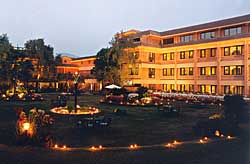 Twenty-five years ago, herds of hippies roamed Kathmandu, the valley was an emerald jewel in the lap of the Himalaya, and there was peace and tranquillity all over the land. A couple of Rana palaces converted into upscale lodgings and the first few budget lodgings were just springing up in Thamel.
Twenty-five years ago, herds of hippies roamed Kathmandu, the valley was an emerald jewel in the lap of the Himalaya, and there was peace and tranquillity all over the land. A couple of Rana palaces converted into upscale lodgings and the first few budget lodgings were just springing up in Thamel. Nepal was a true shangrila and it needed a hotel for a new breed of clientele: not quite hippie and not quite globe-trotting billionaires. Shyam Bahadur Panday decided to take the gamble.
Panday had earlier decided to break with family tradition and not follow his father's footsteps into the army. Perhaps unwisely at first, he invested all his savings into property in Lazimpat near the big embassies. He got a hotel license and decided to start construction. "I had to finish it in time for my children's careers to take off. I could not have them ready to work before the hotel was ready," recalls Panday whose two sons are now managing the hotel.
Luckily, Panday met a group of multi-talented Himalayan specialists led by the famous renaissance man, Desmond Doig, who shared his vision. Doig was a journalist with the Calcutta Statesman, but had become something of a Himalayan specialist, as conversant on Bhutan as he was on Sikkim. But he had a special affinity for Nepal. Perhaps owing to his time as a Gurkha officer, school days in Kurseong among Nepali speaking students, or even as far back as his Nepali nanny, Nepal was always special for Doig.
Panday met Doig one evening at a bar in Thamel and a friendship ensued. Perhaps it was that very night, as Panday shared his dream with his new friend, that Doig envisioned a hotel garden, later called the Shambala. Inspired, Doig moved to Nepal and even as the foundations of the Shangri~la Hotel were laid, he threw himself into the garden of his dreams-a garden which was not even part of Panday's blueprints.
Then, in 1979, the Shangri~la Hotel, inspired by James Hilton's novel of the same name, opened its doors. "Seeing it first," Hilton wrote, "it might have been a vision fluttering out of that solitary rhythm.It was indeed a strange and half-incredible sight." That is what Panday wanted his hotel to be, and the Shangri~la became Doig's canvas as well. Here he brought to life the designs, plans and visions he sketched out on the small pad he carried everywhere. Guided in design only by Hilton's imagery and his own deep passion for everything high Himalayan, the hotel would become one of his masterpieces.
 Although everyone agreed it was charming, the first year was less than smooth sailing for the Shangri~la. Utpal Sengupta worked for the Junior Statesman, a cult youth magazine started by Doig in Calcutta. Utpal came up to Kathmandu and started to work on promoting the hotel. It is said, in Utpal's books you were either for or against the Shangri~la, and if it was the latter, then Utpal had no time for you.
Although everyone agreed it was charming, the first year was less than smooth sailing for the Shangri~la. Utpal Sengupta worked for the Junior Statesman, a cult youth magazine started by Doig in Calcutta. Utpal came up to Kathmandu and started to work on promoting the hotel. It is said, in Utpal's books you were either for or against the Shangri~la, and if it was the latter, then Utpal had no time for you. He and Doig used their contacts to build up the Shangri~la image worldwide. Sengupta even pulled his wife Caroline, who he met at the Shangri~la, and his mother-in-law into helping out at the hotel. Caroline's fine French food and her mother's famed cordon bleu hooked many a visitor. Utpal and Caroline today run Chez Caroline at Baber Mahal Revisited.
Doig only lived a few more years to watch the hotel grow. Sengupta was general manager for 20 years through the tourism boom years. Today, as the ambience of Kathmandu is eroded and the conflict affects tourism, the Shangri~la is still an oasis of calm in a frantic city. And in the middle of that oasis is a tranquil garden called the Shambala, where you can almost imagine Desmond Doig sitting on a garden chair, puffing at a pipe, watching the rose-coloured sunset of a Kathmandu monsoon evening, and sketching away on his notepad.
Panday's eldest son Prasidha is now managing director, younger son Pravine is executive director and Daman Pradhan is CEO of the Shangri~la group of hotels and the Shangri~la Holidays travel agency. So what is it about Shangri~la that invokes such total involvement? Dubby Bhagat, Doig's friend and a self-professed chronicler of the hotel's history, says: "Perhaps it's the spirit of the old Raniban forest that it was built near that consumes them, or perhaps it is the kind of Kathmandu that drew us all here.
www.nepalshangrila.com


